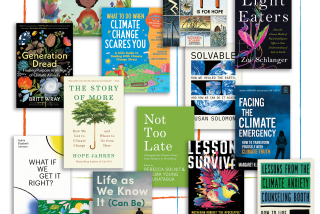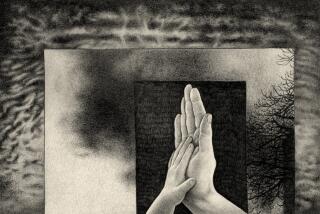
In “Beyond Anxiety,” Martha Beck argues that discovering your creative calling is the antidote to an anxious existence.
- Share via
Bestselling author Martha Beck has tried many things over her 62 years of life to quell the anxiety that’s been her constant companion since childhood.
The Harvard-trained sociologist experimented with therapy, medication, self-compassion practices and many, many hours of meditation.
Then, as collective worry spiked during the COVID-19 pandemic, Beck dug into scientific research on anxiety as she was teaching an online course on creativity, and it led to a thrilling discovery: anxiety and creativity have an inverse relationship. Turn one on and the other turns off.
“It was really one of those aha moments,” Beck, who is also Oprah Winfrey’s go-to life coach, said in an interview. “And I just walked around my room going, ‘I don’t have to be anxious anymore. I know how to shut it down.’”
Shelf Help is a wellness column where we interview researchers, thinkers and writers about their latest books — all with the aim of learning how to live a more complete life.
Even people who don’t consider themselves creative can tap into this inherent capacity of the human brain to step away from worry and live with more connection and joy, Beck says in her new book, “Beyond Anxiety: Curiosity, Creativity, and Finding Your Life’s Purpose” (Penguin Random House).
Beck spoke to The Times about how to identify anxiety’s lies, engage the creative side of our brain and why our worries are linked to the structure of our economy.
This interview has been condensed and edited for clarity.
How did you come to realize the relationship between creativity and anxiety?
I started using a technique that’s in the book that I call KIST (kind internal self-talk). It’s a form of Tibetan loving-kindness meditation for the self. I started to silently repeat to myself, “May you be happy. May you be well. May you feel safe. May you be protected.” And like a drought condition with a little trickle of water coming in, I focused on that trickle of water where there was no anxiety.

Then I found out that just by using kind self-talk, I could get a client to feel calm in five minutes if they learn to focus their minds on wishing themselves well. Then I added the creativity piece. You start with kindness. Be kind to yourself, as kind as you know how to be to anyone. Come back to kindness and your anxiety will come down to calm. But then, because we live in a world that is basically an externalized structure of the anxiety inside our brains, the moment we’re in touch with the world we get spun into anxiety again, unless we have a really hard anchor into something else. The something else is creativity.
So, kindness gets us to peace, and then instead of saying, “What can I do now?” ask yourself, “What can I make now?” That shift takes you into curiosity and into the part of the brain that connects things together and solves mystery — you’re in creativity. And that opens you up, where anxiety closes you down and crunches you.
“Instead of saying, ‘What can I do now?’ ask yourself, ‘What can I make now?’ That shift takes you into curiosity and into the part of the brain that connects things together and solves mystery — you’re in creativity.”
— Martha Beck, author of “Beyond Anxiety.”
You say that “anxiety always lies.” How can we know it’s anxiety lying?
Fear is a natural response to something threatening in the environment. If you see something scary — someone pulls a gun on you or there’s a bear — you’ll have a jolt of very, very clear, high energy that will say, “Do this.” It’s a very dramatic thing, and we don’t need it very often.
But we’re anxious all the time, because anxiety is not about what’s here. It’s about what we think could be somewhere, someday, maybe. So there’s no limit to it. There’s no rest from it, because it’s not real. Anything that we’re afraid of that isn’t happening now is a self-deception. It’s an innocent lie, but it’s still saying, “You should be afraid.” And if there’s nothing to be afraid of and you’re telling yourself, “I should be afraid,” it’s not the truth of your circumstance. It’s not real. That’s why anxiety always lies.
Your insights in this book were informed by the work of neuroanatomist Jill Bolte Taylor, who says the brain’s right hemisphere is home to creativity, compassion and peace, while the analytical, linear left hemisphere is where anxiety lives. The right hemisphere sounds way better, so why wouldn’t we be there all the time?
One of the problems is that the right hemisphere doesn’t track time. We live in a world that requires scheduling and the measurement of time, where people are anxious, where everything is monetary eventually. We’re all engaged in this monetary pursuit, which is the core of our society, and that’s fundamentally anxiety-driven.

Is this why you say we need a new economic system to support more right-brained living? What might that look like?
We’re looking at an economy where familiar structures are collapsing. Our model is a rigid pyramid of wealth and power, with the very rich at the top, all the way down to the poor at the bottom. That is culture. Culture is very left brain. An alternative to that is nature. Everything in nature exists in ecosystems. All living things require space; energy, like sunlight; and water, which is the basis of all life on this planet; and ecosystems will emerge. If you doubt it, don’t clean your fridge for a month and then look inside there and see what’s evolved.
People can create economic ecosystems around themselves. The energy is actually desire: you have a natural desire to fulfill your destiny. The water is your creativity: this is what is needed to give shape to your destiny, to take the next step forward, so you start to make things. And then the space is our time. The idea is to give enough time to identify your real desires and to create whatever happens, and I believe it’s like not cleaning your fridge for a few weeks: a system of value begins to emerge in your life and then it starts to spread.
There’s never been a more important time than now to stop anchoring yourself in structures that are collapsing and start investigating your inherent curiosity. If you can give yourself that space and the kindness to be quiet and start to think, “What can I make?” it gets very interesting.
TAKEAWAYS
from “Beyond Anxiety”
What about people who insist they’re not creative?
When NASA tested adults to see how many creative geniuses they could find to hire, they found that 2% of adults rate as creative geniuses. Someone then thought to test 4- and 5-year-olds and found that 98% of them were creative geniuses. So somewhere along the way, our creative genius gets throttled. If you can be creative the way a 4- or 5-year-old is, it’s pure fun. There’s no judgment.
So you have to bring the kindness factor in over and over. I have a friend who puts together jigsaw puzzles and it calms her and soothes her. That’s her way of doing art. If you cook, by taste especially, you’re doing art. If you plant a garden, you’re doing art. If you throw a dinner party, you’re creating something. You make a sandwich, you’re creating. Every one of us human beings is unbelievably constantly creative.
A lot of people don’t feel creative because they’re physically and emotionally exhausted. The recipe for your life should be this: rest until you feel like playing, then play until you feel like resting, and then repeat.

In the book, you write, “choose to focus on what makes life enjoyable and meaningful.” Sounds like a no-brainer, but why is this so hard to do?
Because the anxious brain says you’ll be safer if you’re always afraid. There’s nothing wrong now, but there will be, so you better stay scared. If you stay scared, you’ll be more productive. But every test they do on creative problem-solving shows that when you’re scared, you can’t do it. It’s just the lie of anxiety speaking through the whole society, and we all agree, “Yes, we should be very worried.” In a society where everything has to be monetized and attention is at a premium, scaring someone will get their attention.
So many people are anxious because their lives are full of demands: work, relationships, family. How do we foster a right-brained approach in that atmosphere?
When you’re in a lot of anxiety, it becomes unbearable. That’s how I found my way through all that meditation to the epiphany. And in situations of turmoil and distress and chaos, there’s more motivation to seek that.
The thing I love about kind internal self-talk is that as you start to bring a little kindness into the equation, you then start to become like one of my favorite Persian poets, Hafiz. Part of this poem he wrote goes: “Troubled? Then stay with me for I am not.” Immediately, the kindness that you give yourself begins to go out to other people. And that makes every interpersonal interaction calmer, more mutually affirming. It takes you into the creativity spiral. It doesn’t just make it calm. It makes it creative. It makes it generative. And if there’s a practical problem to be solved, you don’t want to be in a panic. Any practical problem, any interpersonal problem, any personal problem is made better when we abandon our anxiety, find our kindness and move into what we can make. And then we get so involved with living that way that we transcend anxiety altogether, and we don’t have to go back.
Shelf Help is a wellness column where we interview researchers, thinkers and writers about their latest books — all with the aim of learning how to live a more complete life. Want to pitch us? Email [email protected].
More to Read
Sign up for The Wild
We’ll help you find the best places to hike, bike and run, as well as the perfect silent spots for meditation and yoga.
You may occasionally receive promotional content from the Los Angeles Times.












